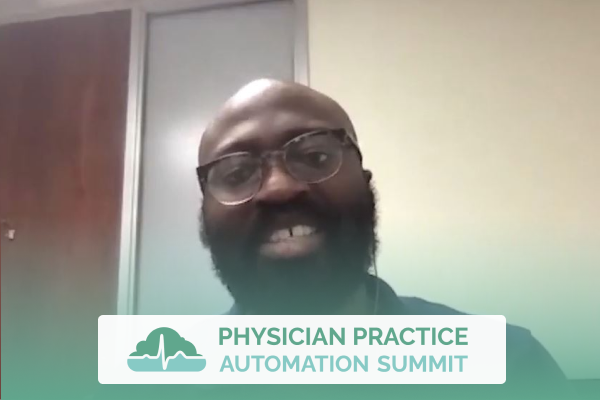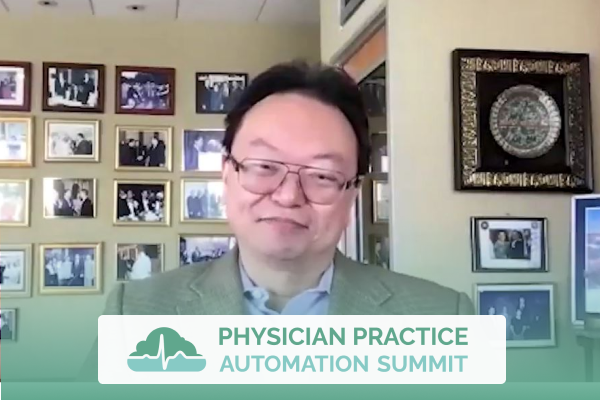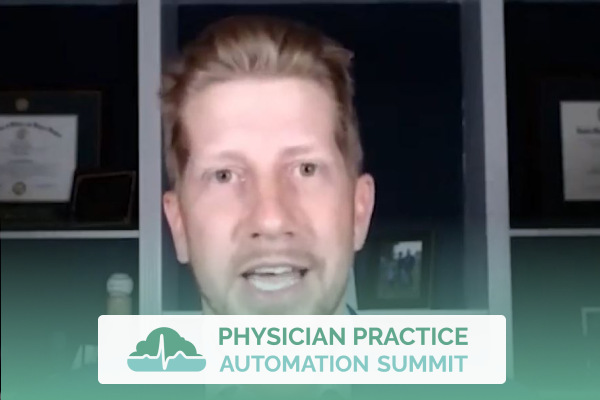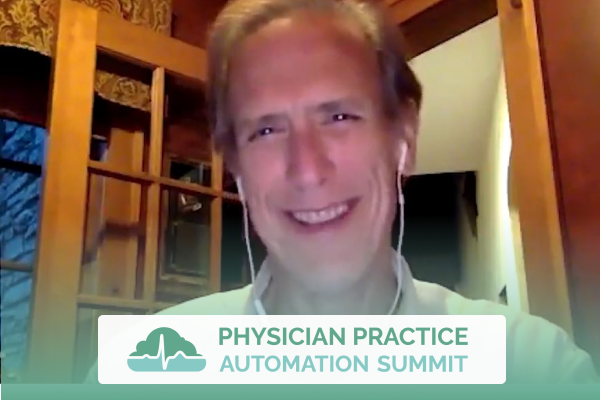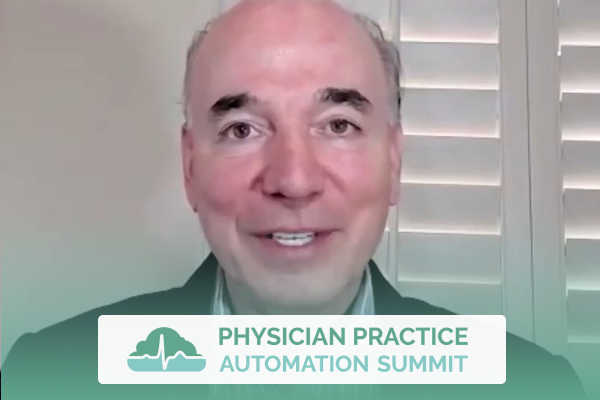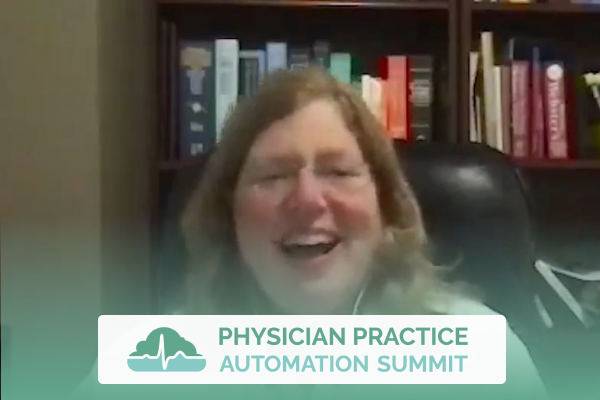Join the discussion below
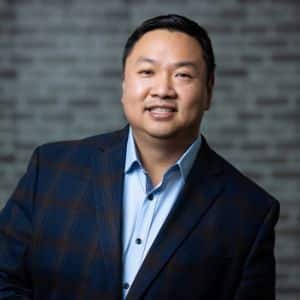
Dr. Ruan is the Founder and CEO of Texas Center for Lifestyle Medicine. He devotes his career in practicing and building systems that allow for efficient delivery of healthcare. He is a board certified internal medicine physician but also have advised with companies to improve their workflow, company culture, marketing,... Read More

Fisayo Ositelu, MD MBA is the Founder and CEO of Gentem Health. Gentem’s mission is to help private practices thrive and remain independent by simplifying the reimbursement experience. Using predictive analytics, AI and automation, Gentem’s physicians are able to get reimbursed more and faster with less administrative cost. Read More
Cheng-Huai Ruan, M.D.
Hi everyone. I have someone special right now. His name is Dr. Fisayo Ositelu. He’s an MD MBA, and the founder and CEO of this company called Gentem Health. So there’s a reason why he’s here because you know, with us at Texas Center for Lifestyle Medicine, we’ve been trying to hack the revenue cycle thing with our practice for a while. And I just realized that we just need a lot more data. So when I happened to come across Gentem on LinkedIn, I’m like, well, what can AI do? What can AI and automation do within the revenue cycle? So it became a whole lot clearer about a month later after I demoed a little platforms. So anyways, so listen, Fisayo, thank you for coming on. I really appreciate you coming on and talking about things.
Fisayo Ositelu
Absolutely. Thanks so much for having me, Chang.
Cheng-Huai Ruan, M.D.
Yeah, no problem. So, you know, well, let’s talk about some pain points first and it’s the perpetual struggle of doctors not understanding the revenue cycle. And being very reactive to what’s in the bank account rather than where’s your dollar or penny coming from? So, can you talk about why physicians are having those challenges, especially with the insurance market?
Fisayo Ositelu
Oh, definitely. I think there are a number of reasons why, but, it really boils down to just the changing reimbursement landscape, the changing policies, updates to the coding, both in the ICD and the CPT. And also the fact that really physicians are not equipped today to keep track of all of those changes, having the knowledge of those changes and the know-how to navigate, how to code appropriately, how to, you know, really make sure that they’re getting reimbursed fairly for all the hard work they’re doing. And there’s just a lot of other things that are technological, you know, issues as well. There’s obviously the knowledge and know-how issues, but I think overall you can view it from a knowledge sort of just really knowing what is out there, keeping track of what is out there and know how actually, how to do it, how to code appropriately, how to bill appropriately.
Cheng-Huai Ruan, M.D.
Yeah. So, but you know, what the problem is though, is that billers have the same struggle as well.
Fisayo Ositelu
Right, right.
Cheng-Huai Ruan, M.D.
Right. So, you know, I think we, as doctors, were like, you know what, I’m going to hire a professional billing company or a coder and a biller, and they’re going to handle whatever things they handle. And when I get in there and look at the numbers, most of the time is over promise and under deliver.
Fisayo Ositelu
Right.
Cheng-Huai Ruan, M.D.
Not only that you realize that in some of the larger billing institutions, there’s clauses in the contracts that allow the billers to automatically write off things, if they foresee it as too hard to get. And these are like, one-liners within the contract, they all existed almost all of the billing contracts that I’ve seen. And so that becomes an issue because, you know, if I don’t know that what I’m doing is getting denied or I’m getting paid for it, like how can you engineer what you do from a business standpoint, if you don’t have that data? So why do you think a lot of billing companies also have a hard time keeping up with the LCDs, the ICDs, the CPTs and the other three letters that we’re supposed to know?
Fisayo Ositelu
Yeah. I think you hinted at it. I think that a big part of this is the technology, just really having the core technology to do this work, mind you, a lot of those folks are coming from a traditional billing healthcare background, which may or may not be the most amenable to really looking at large amounts of data. Healthcare doesn’t really have a track record of building great technology. You know, the healthcare industry as a whole is about 20 years behind other industries with respect to data, you know, how to inter operate from one system to the other integrations, using data in a meaningful way, security, a whole bunch of things.
So I would say the first thing is just the tech and the technology ecosystem. For everyone, every player in this space, there’s also the issue of transparency and visibility, which is one of the things that we focused on early on when we started Gentem. Really making sure that we’re empowering our doctors, our providers, even the billers that we work with, to see all the data, everything in one place, one stop shop, because that’s really the foundation. Once you have that data in one place, you can do a lot of cool things with it, from automation to predictive analytics, to just providing insights about a practice and how they can improve certain key things to drive impact.
Cheng-Huai Ruan, M.D.
Right. So, you know, but I think this is a big problem in the nation, is that what you just said, p;redictive analytics, you know, most docs don’t know what that means. And then the second thing is automation. Automation, when you say that to like practice owners means something different than in the tech world. So, you know, you’re a smart guy, you went to Stanford. So yeah, from the tech world, I think that we, as physicians, are kind of just, well physicians without MBAs like yourself, we, as physicians, are taught to really just kind of look into what’s worked before in the past, and this is the way that we did it, we learned this in training. And then, you know, we’ll let the billing handle this. And as long as there was nothing in the bank account, that’s all we really care about. But you know, my company went through a period where we analyzed other different practices in their financials and stuff like that. And we see like big time leaks of money that just kind of goes into black box.
Fisayo Ositelu
Right.
Cheng-Huai Ruan, M.D.
Right. And whether it’s, you know, if it’s a previous employee or something like that, and there’s very little, and every time we analyze a company, because we were in acquisition mode, right before the pandemic. So every time we look at a physician company, there’s a lot of nervousness amongst the people who control the data, which is not the doctor. It’s never the doctor. The doctor may be the owner of the practice, but they don’t control the data. So we look at the data, we’re like, well, this doesn’t look right.
Fisayo Ositelu
Right.
Cheng-Huai Ruan, M.D.
And we approach the physician owners. Well, this has been like this for the last 30 years, you know? What do you want me to do? I was like, well, it looks like you earned $14 million in the last 30 years?
Fisayo Ositelu
Afraid of fraud. There’s all kinds of stuff that you uncover when you dig deep, and in fact, you’re absolutely right. Folks get nervous, you know, for one reason or the other, once you actually get into those numbers. And sort of digging in, things that are writing off, even collecting from the front desk and keeping track of those payments. If you don’t have that visibility and transparency, you’re just bleeding, bleeding money, essentially.
Cheng-Huai Ruan, M.D.
Yeah. And, you know, I actually experienced that firsthand because we didn’t, when we first started, when I first started the practice, didn’t really have a grasp on,
Fisayo Ositelu
Right.
Cheng-Huai Ruan, M.D.
On policies and procedures for collections. I mean, we had a rule there, but you know, what happens if it doesn’t get done? You know, none of that stuff was available. So I think, you know, when, when Gentem came into the picture, I think that the most important thing is how, you know, here are the numbers, how do I turn numbers into words? I mean that, okay, I know the numbers, what do we do next? And then how do we predict the future? Predictive analytics, like you said.
Fisayo Ositelu
Right, right.
Cheng-Huai Ruan, M.D.
And so, and I feel like a lot of practices don’t have that because they think, oh, maybe it’s our office manager’s role or CFO’s role, but believe it or not, a lot of the non-physician administrative staff do not have an incentive to change anything, because there’s a comfort level that’s there. And the minute that you get more analytical is when the discomfort sets in, they’re like, okay, well, and not because they’re dishonest people, they’re like they have a pride and rightfully so, they have pride in the practice. And you’re really uncovering things down to the penny that we don’t know where the allocation is. And Hey, you know, why do we get $7 less per patient for Cigna for the last six months, right? And the less physicians looking at it, there’s not necessarily incentive for a lot of these stuff change because the pain of changing is way to hard, but depending on the physician culture.
Fisayo Ositelu
Right. And that’s the promise of automation, right? Because if you look at automation holistically, it can be broken down to a few things. One of which is RPA robotic process automation. And this looks at more repetitive tasks. Things like checking your eligibility and benefits verifications, things like checking claim statuses, things that are very defined and repeatable workflows. And you essentially build a bot or robot that just does that over and over again, based on those parameters, right? And if you think about the amount of time that practices are investing in, you know, just making phone calls to payers or doing this, going from one insurance company’s website to the other and doing these manual tasks, it really does not, it’s not a good use of time and resources.
And so the way we think about these things is that how can you free up time, so that folks are doing the highest value thing within that organization, right? The things are really going to move the needle, the things that are gonna drive revenue and improve patient care, most importantly. So that’s just one pillar of automation. Then there’s the predictive analytics, right? Where you have some kind of model you train looking at historical data, right? And that can help you literally, let you know if X, if we see this pattern, then Y, this is what it means, right? Looking at historical data, using other data inputs.
And the only way to do that is to actually have your data in one place to have that data in a format that works for that kind of analysis and automation. And so that’s one of the things that we focus on really bringing that data into one place, normalizing the data, streamline the data so that you can start to get those insights, whether it’s understanding your best performing procedure codes and why it’s performing best. Looking at different parameters, like pairs, like even the kinds of codes you’re using, understanding all those inputs really makes a difference so that you can make the best decisions for your practice.
Cheng-Huai Ruan, M.D.
Right. Yeah, you’re absolutely right. So, you know, speaking about code, so whenever we were building out these codes, I think for most physicians, we’re like, okay, I’m going to put a 99214, whatever it is, and hit “done” on the note or check off on the note and that goes to biller, and then it goes into this magical fairy dust. And then, we see if we get paid or not. But not necessarily on that code, but to see if money comes into the bank account.
Fisayo Ositelu
Right.
Cheng-Huai Ruan, M.D.
And I think that era really has to stop because this is literally how doctors are taken advantage of by, you know, the insurance companies and bureaucracy and stuff like that is because that magical fairy dust is not really investigated, right?
Fisayo Ositelu
Mm hmm.
Cheng-Huai Ruan, M.D.
And so.
Fisayo Ositelu
Yeah, yeah. Absolutely. And, you know, that’s a huge, huge point because, yeah, at that point you’re just getting scraps, you know, and if you don’t know what you deserve to get, you know, you can be taken advantage of. In fact, one of the things that we do is to really look at underpayments, so really understanding what should that code reimburse based on your contract, based on what should be reimbursed and investigating that to what was actually reimbursed, right? And so by the time you’re sending these claims, you should know what you deserve to get paid based on the contracts and based on what’s happening from the payer. And, and then, you know, if that does not happen, you should be empowered with the data to actually fight and get that reimbursement, that Delta that you’re missing.
Cheng-Huai Ruan, M.D.
Yeah. We actually did that manually, a few years ago, except I didn’t really catch it until two 11 months later.
Fisayo Ositelu
Wow.
Cheng-Huai Ruan, M.D.
I’m like, like, why is Aetna shortchanging me $12 on each of these codes right here? So by the way, we didn’t get recouped for that money for three years. All right?
Fisayo Ositelu
Wow.
Cheng-Huai Ruan, M.D.
And part of it is we weren’t really able to supply a whole lot of proof other than some EOBs and then there’s departments and appeals departments and appeals departments and appeals. And then three years later finally got it. And it was so like crazy
Fisayo Ositelu
Terrible.
Cheng-Huai Ruan, M.D.
because like, if we didn’t have a good financial health in the rest of the practice and other doing other things, like how can like a solo doc survive on this, you know? It’s just not possible. And I think that, and the end of it, they’re like, oh yeah, we had a glitch in the matrix or something like that. Sorry about that. And this is three years later, which, and there’s multiple class action lawsuits that are going on for stuff like that currently in some other insurance companies. But it’s a daily thing. I think that we have to use the same weapons that the insurance company is using to do this. And that’s with, I think, automation, artificial intelligence, machine learning bots and whatever it is. So I’m glad you, I’m glad Gentem’s really offering that to the masses here.
Fisayo Ositelu
Right, right.
Cheng-Huai Ruan, M.D.
And so how did you come up with this? You know, what, like what, why did you even start Gentem? ‘Cause I know you went to, you got your MD and MBA at Stanford, right?
Fisayo Ositelu
Right, right.
Cheng-Huai Ruan, M.D.
And then, so how did you come up with that?
Fisayo Ositelu
Yeah, definitely, I can tell you, I can tell you a quick story about how this came to be. So I, you know, I did my MBA at Stanford and towards the end of my third year, I knew I was not going to practice medicine. So unlike a lot of my colleagues, I did not actually apply for residency primarily because I wanted to do more sort of macro things and sort of have a bigger impact from a tech standpoint. But also I would say I saw my attendings and really how they work with the EMRs and just the documentation, the constant back and forth with insurance companies. Even at a teaching hospital like Stanford you’d be surprised. No one was spared from all that administrative work. And so that really, the combination of those two things made me go more of the business route. So I did my MBA at Stanford as well.
After that, I ended up working at a startup called Nerd Wallet. It was an early stage startup at the time, but Nerd Wallet is they offer, you know, marketplaces for financial products. And, you know, it’s just really a place where you can make the best financial decisions on credit cards, loans, all that kind of good stuff. So that’s where I really got my baseline learning about startups, the tech world, you know. Nerd Wallet is based in San Francisco. So really thinking differently about impact, business and how technology can really, you know, affect folks in a positive way at scale. So after Nerd Wallet, I dumped into private equity where, you know, I was the VP of the healthcare business and these folks were, wrote up a number of revenue cycle and billing companies. And that was what really gave me exposure to like the whole shebang of revenue cycle. I was working with large health systems.
Think of just some of the biggest health systems in the country. And you will not, you will not believe all the waste, all the paperwork, manual work, just the number of people devoted to the most manual tasks that just have to be done just the way the system is today. And it was just very hard to get folks paid even at the systems level. And so I was like, wow, if it’s, if it’s this difficult at this level, what about the independent doctor? What about the sole practitioner? The folks that wants to help their own community and do something that is more accessible that because we all know that getting care in an outpatient setting, non-hospital affiliated setting is way cheaper, way affordable or more affordable, relatively speaking than a hospital, right? In fact, there’ve been studies that show that you actually get higher quality care in non-hospital settings. But what we’re seeing is that the tide is going towards consolidation because it is so hard. It is so hard for doctors today, independent private practice today to just keep the lights on, to be able to remain independent, right?
So it was really that realization that really made me want to focus on the specific segment of independent medical professionals, doctors, and surgeons, and what have you. And I think in addition to, and the insight is that, how can you build tools? How can be an infrastructure to enable doctors get paid on time and in full? How do you simplify this entire process end to end? How do we bring some of the technologies that have worked in other industries at scale? How do you bring that to healthcare, modern technology, modern user interfaces, powerful software in healthcare, right? And that’s really the Genesis of Gentem, right?
Gentem is Latin for revival. It’s a Latin word for revival. We want to revive private practice, independent doctors, you know, the community doctors that are just getting started and just give them the tools to be able to thrive in this environment. And in addition to the tech chain, what makes us unique is that we layered on a FinTech play where we’re able to pay for claims upfront. So instead of folks waiting months to get paid, weeks to months to get paid for practices that we have deep integrations with, we can just pay that claim the moment we submit it to the insurance company and take the risk on the backend. So, and the only way you can do that is if you actually, if you have powerful data and you can literally predict what is going to get paid. So it’s not a trivial problem. So we spent a lot of time building this kind of capability. And so, yeah, that’s a nutshell, you know, how Gentem came to be.
Cheng-Huai Ruan, M.D.
That’s great. So that’s interesting because it’s like you get cashflow the minute the claim is submitted, not waiting for the insurance companies to come back necessarily.
Fisayo Ositelu
Right.
Cheng-Huai Ruan, M.D.
And, but with the reason you have that power is because you have the predictive analytics to say, Hey, there’s a high chance I’m going to get paid for this based on this code, based on historical data, right?
Fisayo Ositelu
Exactly.
Cheng-Huai Ruan, M.D.
And I don’t think a human can do that on a large scale because there’s a lot of statistics that go into that.
Fisayo Ositelu
Exactly.
Cheng-Huai Ruan, M.D.
So, the other thing is, if there’s technology that can support this, I’m assuming that what you’re also trying to do is decrease your own fixed costs by having less humans do the things and have them be more of the leadership role to help the practice, right?
Fisayo Ositelu
Right, exactly. And that’s our philosophy, and we believe that should also be translated to the practice. You know, there’s some codes that, and I think we were talking about this some time ago, a couple of days ago, regarding how we were able to help your practice with some of your cost structure, because of, you know, how, you know, we’re able to help with reimbursements and just improving the bottom line, so to speak. And maybe you can share a little bit more about that, but from our side, we’re laser focused on how do we make sure our folks are working on only an exception basis.
What that means is that the rule should be everything flowing through on its own automatically. And we should only have human intervention when there’s an exception or something like a long tail thing, something they need to review. And typically we want this to be less than 10% of the entire workflow, right? The entire transactions. So that’s really how we approach it. We look at every part of the revenue cycle, you know, both holistically and to stage by stage. So from eligibility, to coding, to submission, to claim status checking, came in, posting, all that stuff and just be laser focused, how can you automate this? How can we increase the quality of the work being done here, monitoring over and over again?
Cheng-Huai Ruan, M.D.
Yeah, that’s great. You know, with our practice, for example, one of the that we notice is that with more of the analytical stuff that’s coming through, we’re going back into aging claims, you know, back a year ago and seeing, oh my God, how do we, how do we miss this? Can we change this please? We’re actually able to find quite a bit that was left on the table. And I think I was telling you before that, with Gentem last month was our most profitable month because just the sheer amount of data that we got and it changed, like, all we did was a one to two millimeter shift in our processes and procedures.
Fisayo Ositelu
Right.
Cheng-Huai Ruan, M.D.
And I was, well, oh, okay, I wish I knew this a few years ago, right?
Fisayo Ositelu
Yeah, docs can be even as much as 10, sometimes 15, we’ve seen some pretty, just bad, you know, just billing operations. It’s kind of sad because you have folks working very hard and they’re just not able to realize the benefit of the work. And they’re not even able to stay afloat because they’re filling up a leaky bucket, right? It’s a leaky bucket and you need to plug those leaks so that you can actually have the water to take, you know.
Cheng-Huai Ruan, M.D.
That’s incredible how much, how many leaks there were in our bucket as well. So I think, and, you know, I considered us doing pretty good even before, ’cause I’m, you know, I certainly knew a lot more about the revenue cycle than my physician counterparts. Yet we were still leaking, you know, quite a bit, six figures, by the way, it’s quite a bit that we actually leaked, and we were able to recover within three months, right?
Fisayo Ositelu
Yeah.
Cheng-Huai Ruan, M.D.
And so I think that the lesson here is that without data we’re flying blind, right? And with data, we’re able to curate and do the things that we want to do and standardize our procedures. And not only that, decrease our fixed costs. If I have too many employees focused on one thing, then not a whole lot gets done. And if I know the return on that investment for the employee is not very much, then I’m gonna want to change the system. And that’s what we did. We continued to do that with the revenue data coming in. So, you know, for example, the idea of a medical assistant, and as cynical as it sounds, the idea of a medical assistant sounds really silly to me because here’s what the medical assistant’s supposed to do. The medical assistant is supposed to assist the physician, that’s it, right? And if he goes to every practice, every medical assistant has a different set of roles. There’s a medical assistant for this and this and this and this and this and this.
Fisayo Ositelu
Right.
Cheng-Huai Ruan, M.D.
And so what happens is that this structure has been here for the last 600 years, at least. The doctors having medical assistants, right? It might’ve worked in 1927, but right now with the digital data to decrease fixed costs, you might need virtual assistance, right? And you might need, and we decreased our footprint in square footage in our facility during COVID because now a majority of our staff is not in our facility, it’s working off-site. And so, and I think that, you know, people understand like for every penny or every dollar that you save, it’s a dollar worth of profit, for every dollar that you earn, it’s 30 cents worth of profit, if you’re lucky, right? And that’s the thing here, and it’s not about just revenue cycle management. It’s not about just getting money is about using the information, decreasing the fixed cost and take away a lot of the bloat within processes within the medical facility. And all of a sudden, even without increasing your revenue, your profitability is two X, you know, like over a span of, you know, two to three months.
Fisayo Ositelu
Right.
Cheng-Huai Ruan, M.D.
And that’s actually what we’ve experienced, you know, ever since the pandemic. So this idea that something should be done that always has been done should really change. That’s the whole point of The Summit. The whole point of The Summit is we’re going to abandon all the crap that didn’t really work before.
Fisayo Ositelu
Yeah, I think you’re absolutely right, and I’m glad we’re able to help in that way in a very material way like that. But I think you’re absolutely right. I think that just changing the mindset and because really, as doctors, you owe it to yourselves to be able to thrive in this environment, to be able to adapt in this environment, to be able to look at your entire cost structure and optimize and cut out the extraneous things that are not needed. And you also owe it to your patients too, right? The patients that really rely on you, I mean, they’re getting great care. They want you to succeed. And, you know, we really, as doctors really need to just take a very deep look at this.
Data is really going to be, is the answer, using the data in the right way is the answer. The data can actually, you know, we’re talking about this, you know, a few days ago as well, but thinking through how the data can incentivize you to do the right thing. So for instance, a lot of these newer codes that have been released that are supposed to promote communication between one doctor and the other, right? How can you start looking at those new service lines, as ways to improve your, both your top line and also your bottom line, right? And you’re doing the right thing, you’re doing the right thing by promoting communication, breaking the barriers between, and the silos between one doctor, one specialist, one surgeon, and an integrative physician, or a primary care physician. And it really goes a long way. And these are the things that you need to capitalize on in order to thrive in this new environment.
Cheng-Huai Ruan, M.D.
Absolutely. So, yeah. Speaking about the patients, talk about improving healthcare for the patients, right? And that was really a good example. So, and I want people to understand this. So there’s a little of anxiety that pops up for most doctors is he’s like, hey, can you talk to my surgeon about what you’re thinking? And can you talk to my cardiologist, right? Can you talk to, to whichever specialty, can you talk to my primary care? And then all the doctors thinking about when the hell I’m going to have time to call and arrange these meetings, right?
Fisayo Ositelu
Right.
Cheng-Huai Ruan, M.D.
Until, you know, you understand that your texts or phone call, if it hits five minutes, you actually generate more revenue per minute than seeing the actual patients, if you talk to the consultants or the primary care. And most people are going to be hearing this for the very first time out of my mouth, but I know because we have data. And so that’s why I allocate half day a week for me to talk to other physicians is because it’s a good revenue model. And guess what It over delivers on the patients. And then whenever we send the patients, hey, it talks to your gastroenterologist. They just want you to know, we agree on everything, let’s move forward. And they are so grateful, right?
Fisayo Ositelu
Right, right.
Cheng-Huai Ruan, M.D.
And guess what, when they, and by the way, they do sign releases of financial policy that get billed for it. But when they get that bill, they love it. All right. They’re like, you know what, I’m happily paying this because you just talked to my doctor, when no one else did. And that is, the communication is really where the future of medicine goes. And I think that’s where AI and techs should really focus on bringing people and communication together between doctors and stuff like that. Because right now, I think there’s just too much animosity between physicians, especially during COVID, but you can’t do that without looking at the data. Right?
Fisayo Ositelu
Right. No. And you know, you absolutely hit the nail on the head, you doing the right thing, by communicating with all the stakeholders in that patient’s care journey, and you’re getting paid for it, right? You’re getting paid to do the right thing. Communication remains perhaps the biggest barrier in healthcare that makes things broken. And once you start breaking those silos, those barriers, you start to see a lot of great things. It certainly is good for the patient because the patient experience is elevated. The doctors are rewarded for doing the right thing.
It’s no longer a thankless task where, you know, you’re just dreading spending all this time, but provided, you know, so you said that some of the doctors the first time, so this is the knowledge piece, the knowledge gap, right? Filling the knowledge gap. And then, you know, the know-how gap, which is where all the, the tech, the automation, the analytics really lets the doctor see the data that drives that decision to like, oh, well maybe I should really invest more in doing this stuff. Why? I can see how this could affect our, you know, our top-line in certain ways or even patient outcome, you can track a whole bunch of things, right? From financial to clinical. But having that data is so critical in this scenario.
Cheng-Huai Ruan, M.D.
It’s no longer critical. It’s a necessity because I think critical is still optional, but necessity is actually needed because I’ve seen too many of my friends kind of go south, you know, and I have two of my really close friends that’s doing startup, you know, medical practices right now. And, you know, I kind of smile a little bit ’cause I don’t think they know what they’re in for, but at the same time, it’s a nice fresh start during the pandemic era to really kind of rethink the roles of different people. You know, and I advise them, you got to get virtual assistance, you know?
Fisayo Ositelu
Right.
Cheng-Huai Ruan, M.D.
Because they actually have full-time capability of doing things, very focused. It frees up your MAs and then, you know, things can kind of marry together. I think that there’s an intimidation here. I’m going to talk about billing in general. So they usually have a private practice doctor with billers that they hire full-time or part-time, or you have an outsource of billing agents or revenue cycle management, right? And generally, the percentage cut of the biller and coder is usually pretty dang high and people don’t know what high is, but it’s actually pretty high. When you’re approaching, you know, 6.5-7%, it’s pretty dang high because that’s a lot of money. And what comes out of that is usually something that’s really under delivered, right? And so I think there’s an intimidation on the billing companies, the billers right now, because how much has changed since the pandemic, you know?
You know, every other day, you know, during the height of the pandemic in April, yeah, April or May, CMS has come out with brand new things, you know, bill this at location 11, no, actually do location number two for telemedicine. No, don’t put location at all. You know, and then, and these are like being put out on like national media. And so, and I received this information ’cause I’m very familiar with billing codes, but with average doctor who doesn’t necessarily do it, but then whenever I talked to other billing companies, like they’re behind on it. And not only that, most of the billing companies I’ve spoken to didn’t know that you can get, you can bill for your doctor talking to another doctor about a patient, that’s actually a billable event. So I don’t think there’s an intimidation because there’s not really incentive for these companies to go after it because the minute that the insurance company sees the new code coming out, they pause you on the revenue cycle. Wait, what is this code, right?
Fisayo Ositelu
Right.
Cheng-Huai Ruan, M.D.
Let’s have you submit some more notes, which AKA is insurance company say, let’s buy you buy some more time to see if they just leave this alone.
Fisayo Ositelu
Right.
Cheng-Huai Ruan, M.D.
And without data and without the like, and especially with what Gentem provides on that data, what does that lead time? And what does the tail time behind that? You have no fricking clue. And so how are we going to engineer and re-engineer health if we don’t have that data? But the intimidation of billing companies there. And I think it’s good is because we have to propel into the future and bring hands into the doctor’s practices into the community practices and then to do that, we have to get really high quality, accurate data over time and predictive analytics, you know?
Fisayo Ositelu
Yeah. I think you nailed it. I think this is the time to be bold. And you know, and I’ll speak for myself in medical school, sometimes you, you just, the psychology is that, you know, you always want to sort of feel like you, you know it all, or not even know it all, but just have that confidence that you know what you’re talking about, but it’s okay not to know as long as you are going and you want to learn and you have the right mindset around data around just, hey, we’re learning and I want to improve. I think that’s the right mindset. The thing about the billing companies, as you mentioned, is some of them charge a lot of high percentage, but they’re going after the low hanging fruit, right?
Cheng-Huai Ruan, M.D.
Yeah.
Fisayo Ositelu
And if they’re not able to improve your collections, materially 10, 15, 20%, that math doesn’t work. You’re actually, your margins are actually going to shrink. So you’re just going to have this crew taking a whole bunch of real revenue. And it’s the same old thing. They’re not bringing anything new to the table. They’re not keeping up with all the new changes, the policy changes. They’re certainly not bringing tech or they just, it’s just a lot of talking, but no actual delivery and you just need to hold them accountable. You need to see the data. You need to really have the confidence. And don’t be afraid to rock the boat in some ways, because if you don’t rock that boat, you know, you’re going to sink with the boat. You know, you have to, you know, ’cause now is a very instrumental time. As you said, it’s a necessity, now. It’s not a luxury, it’s a necessity to be able to use data to make the best decisions.
Cheng-Huai Ruan, M.D.
Yeah. So, you know, as you’re talking about this, I’m having flashbacks through our own billing, billing companies, stuff like that. And I’ll tell you guys I’ve experienced everything this man just talked about, rocking the boat, finding things out, being just absolutely stunned at how much is left on the table. Went to another billing company, stunned again, went to another one, stunned again. So I feel like every year we had a new one. But what it really allowed me to do is to see exactly what’s really screwed up about the revenue cycle and the system. I learned so much by just being very analytical. I’m not expecting other doctors to do that. What I’m expecting other doctors do is learn from all of us, please learn from all of us. You don’t want to taste that pain point from all of us, you know?
Fisayo Ositelu
Right.
Cheng-Huai Ruan, M.D.
And so I’m, I’m very glad to work with you guys and Gentem. I’m very glad to have you guys give me the opportunity to actually look at really cool data that I didn’t think was possible to even get. And then when we turn the data into words then we know, hey, I want to scale here. I want to shrink here and I want to move some pieces here and it’s like playing chess and it’s kind of fun.
Fisayo Ositelu
Right? It’s great. And it’s been a pleasure to work with you. And we’re just getting started. I mean, once we actually get deeper integrations and it’s going to be not any different from what you’re seeing now, but it’s very exciting to work with you as a leader. And, you know, I think this is just the beginning. There’s a lot of cool things to build together and, you know, and potentially even help more and more doctors that could really use some support in this area.
Cheng-Huai Ruan, M.D.
Oh yeah, absolutely. So, you know, I’m going to ask you a question that I asked most of The Summit speakers and you can take your time in thinking about it, but so when did Gentem start? What year?
Fisayo Ositelu
2019 Two years ago.
Cheng-Huai Ruan, M.D.
Yeah. All right. What do you know now that you wish you knew back in 2019 when you first started Gentem and keep it to one thing.
Fisayo Ositelu
I would say the biggest lesson over the past two years is consistency. It’s a very boring word, but it’s a very powerful thing. Just being able to be consistent, whether it’s in your messaging, to the market, just being, you know, for us, we’re really focused on independent medical providers. You could be a solo practitioner, you could be, have a surgery center, but just the folks that are doing this out there in the market consistency in our quality of work, right? You know, just holding yourself to that standard and being consistent because it’s very easy for things to slip as you grow as, you know, one thing or the other, but there’s such a power there and it compounds over, over and over again, the more you do it. And so it’s a very powerful thing. And I wish I, you know, I wish I knew the power of consistency, right from the beginning, because it’s something that, you know, we’ve just because that’s just the way we do things. But we’ve learned from a lot of our customers, our provider partners, that this is something that they value. They know that we’re gonna give them consistent work, consistent reports, you know, that kind of thing. So that’s the thing that really comes to mind.
Cheng-Huai Ruan, M.D.
Yeah. So I agree with you there because I think that whenever you’re in a company, whether it’s a medical practice or a tech company, consistency seems counter-intuitive when you have to innovate to change. But part of consistency is that you have to be, you have to consistently innovate as well.
Fisayo Ositelu
Right right.
Cheng-Huai Ruan, M.D.
And shift. And so, you know, I think your definition of consistency is not, hey, do the same thing all the time and oh, you know, it’s be essential to your values and your goals, right?
Fisayo Ositelu
Right.
Cheng-Huai Ruan, M.D.
It’s a very mature thing to say because a lot of companies not even startup, large companies struggle with that consistency of sticking to the core values, because even us, we dabbled here, dabbled here and dabble here. What happens is that our essential core process was compromised because of the dabbling in the allocation of resources. So I, a hundred percent.
Fisayo Ositelu
No, this, you’re absolutely right. Just being, just looking at that end result, I really want to help Dr. Ruan’s Texas Lifestyle go to the next level consistently, just hammering on that. And once you have that true, that true vision, you know, you’re going to innovate as all part of that consistently innovating. You’re consistently not letting things dropping the ball on this little thing or the other, you know, you’re consistently just doing what needs to be done, right? Making sure that that foundation is strong, you know, otherwise we’re just going to be all over the place. And then things just start to fall through the cracks, which we don’t like at all.
Cheng-Huai Ruan, M.D.
Yeah. And that’s really part of being a great leader too, is that consistency of delivering value to your staff, to the people who kind of look up to you and then serve those people. And I told, I’ll speak in another Summit leader that, hey, you know, the way I view myself is I’m the CEO of Texas Center for Lifestyle Medicine, but I don’t, my employees don’t work for me, I work for them, right? And that’s always going to be, you know, my consistence, bias, if you will, right?
Fisayo Ositelu
Right.
Cheng-Huai Ruan, M.D.
And so I think that’s really lost. And I think from a medical practice point of view, we also have to be consistent with our patients too, because guess what if the patient has inconsistent like billing standards, if they’re getting a bill for something that was done a year and a half ago, because the revenue cycle didn’t really, really match up, which happens, it absolutely happens. Literally a bill can be like for something a year ago, that’s inconsistency. And then it’s because something happened within the revenue cycle that didn’t really match up and they’re getting EOBs later and they’re like, oh, you’re just doing fraud. So that is very, very common. And then the doctor was like, well, let’s just write it off. I mean, it’s been a year, right?
Fisayo Ositelu
Right.
Cheng-Huai Ruan, M.D.
You can’t make that mistake because those add up to millions of dollars per doctor over years, you know, that’s more than retirement, just that small amount of inconsistency. And so, but, but thanks for being on, man. I know we’ve talked for a long time. I kept you for a long time. Thanks for being on.
Fisayo Ositelu
It’s a pleasure. Always a pleasure.
Cheng-Huai Ruan, M.D.
And so, but yeah, guys, if you, if you want to trial Gentem has a really cool service where they actually do a whole analytics for your practice free of charge. And the link is in the description below. You can’t lose. We found about 350 grand just in my practice, FYI on the analytics and actually came true a few months later. So it was really nice to recover those charges. But yeah, just click on that. And if you have any questions, you know, in the link, there’s also a form that you fill in once and then you can submit your questions over there as well. But go ahead and just take a look and, you know, you can’t lose as long as you’re willing and open and honest about what you might find and be excited about the errors that are fine and, and know that the mentality is for you to fail forward, that you want to fail right now. So click on the link. So thank you guys. And thank you, Fisayo, for being on.
Fisayo Ositelu
Thank you, Chang, really appreciate it.
Downloads

